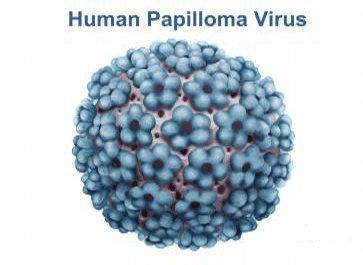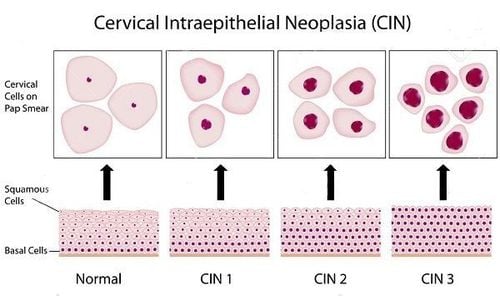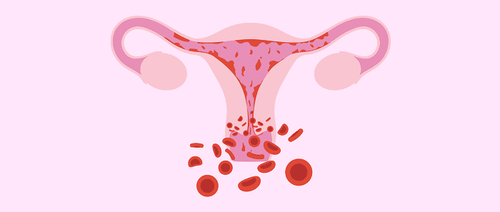This is an automatically translated article.
The article was professionally consulted by Specialist Doctor I Pham Thi Yen - Department of Obstetrics and Gynecology - Vinmec Hai Phong International General Hospital.
Cervical dysplasia is an abnormal growth of cells on the surface of the cervix. Symptoms of cervical dysplasia if not treated promptly can lead to cervical cancer.
1. What is cervical dysplasia?
Cervical dysplasia is a process by which cells in the cervix are changed, under the influence of an inflammatory agent, a change in the vaginal environment or by infection with the HPV virus. This change of cells in the cervix can be benign or transform into a malplastic or precancerous stage. People who have an unsafe sex life, have many sex partners or make love too soon before turning 18, women giving birth before the age of 16, have an immunodeficiency disease, use suppressive drugs immune... are subjects at high risk of cervical dysplasia.
2. Causes of cervical dysplasia
According to the results of research from many women with cervical dysplasia, the HPV virus was found here. In fact, HPV infection is very common in women and men, but the virus usually affects sexually active women under the age of 20. In most cases, the body's immune system will clear the HPV and clear the infection naturally. However, in some women the infection persists and leads to cervical dysplasia. The HPV virus is usually transmitted from person to person during sexual intercourse. Both anal or oral sex can be infected. In addition, the virus can also be transmitted by skin-to-skin contact with a carrier of the virus.
In addition, women with chronic HPV infection, women who smoke cigarettes can lead to cervical cancer and death twice as high because smoking weakens the immune system. Chronic HPV infection and cervical dysplasia may also be related to factors that weaken the body's immune system, such as: use of immunosuppressive drugs, after an organ transplant, or HIV/AIDS infection. AIDS.

3. What are the symptoms of cervical dysplasia?
Early stages of cervical dysplasia do not cause obvious symptoms. At a later stage, the patient has a few symptoms but is very vague, the main manifestation is abnormal vaginal bleeding such as bleeding between menstrual periods, bleeding after sex, bleeding bleeding after douching, bleeding after a period of menopause. Some other signs can be seen such as: pelvic pain, pain during intercourse, white and foul-smelling discharge...
Dysplasia is usually detected through the PAP test, so women It should be done regularly to detect changes in cervical cells during routine gynecological exams.
4. Does cervical dysplasia lead to cancer?
In fact, dysplastic cells look a lot like cancer cells, but are not considered malignant. Because these dysplastic cells remain in the epithelial layer of the surface of the cervix, they do not invade other healthy tissues in the cervix.
However, cervical cell dysplasia is the earliest stage of abnormal cell growth, which has the potential to progress into malignant cancer cells. Progression from cervical dysplasia to cancer takes 10 to 15 years.
5. Can cervical dysplasia be cured?

Usually, cervical dysplasia is divided into 3 stages.
Mild dysplastic stage (CIN I)
C Abnormal cells are limited to the outer third of the cervical cell layer, including cells transformed by infection with the papilloma virus HPV people. Stage I CIN is common in women between the ages of 25 and 35. About 45% of cases with mild dysplasia do not require treatment, and the abnormal cells gradually return to normal afterward.
Stage of moderate dysplasia (CIN II)
Abnormal cells have occupied half of the cervical cell layer. At this stage, it is often used to destroy abnormal cells with laser or cryotherapy. Surgery can also be performed to remove the abnormal dysplastic cells.
Severe dysplasia (CIN III)
The entire layer of cervical epithelial cells is dysplastic, but these cells have not penetrated the basal cell layer to penetrate the subepithelial tissues of the cervix. This type of lesion is also known as cancer in situ. Stage III CIN is common in women between the ages of 30 and 40. At this stage, if not treated in time, severe dysplasia cells have a high chance of penetrating the basal cell layer of the cervix and spreading to other organs and organizations in the cervix. The process of spreading to other organs and organs often takes months or years and is called invasive cervical cancer.
In the case of severe and persistent dysplasia, treatment aimed at destroying or removing the abnormal cells is essential, because of the risk of progression to cervical cancer in cases of severe dysplasia is very high. To proceed with the treatment, a small cone-shaped area of tissue containing abnormal cells is removed from the cervix. This surgical method is carried out through the vagina and under the effect of local anesthetic, the operation time is from 5 to 10 minutes. In more severe cases where the abnormal cells are severely distorted, a larger cone-shaped area of the cervix is removed under the influence of anesthesia. For older women with dysplastic lesions in stage III (CIN III), complete hysterectomy and two appendages (2 ovaries, fallopian tubes) are recommended.
After treatment, the patient may experience bloody discharge for several weeks, but the cervical cells will gradually return to normal. Three months after the treatment, the patient had to undergo smear surgery and vaginoscopy to make sure there were no abnormalities after the treatment. This is followed by smear tests every 6 months, longer than yearly, until advised by your doctor.
6. Laparoscopic appendectomy before turning to malignancy at Vinmec Hai Phong
In the case of severe cervical dysplasia in elderly women, with a high risk of developing malignant and metastatic cervical cancer, doctors will consider the indications for total and adnexal hysterectomy to prevent cervical cancer. prevent disease progression.
Laparoscopic appendectomy at Vinmec Hai Phong International General Hospital will help patients deal with pathological appendages, with a much faster recovery time than laparotomy and maximum limitation. prophylactic antibiotic use. The surgery is consulted and approved by the professional director, the head of the obstetrics department, the anesthesiologist, and performed in a clean operating room, ensuring sterile conditions. Experienced obstetricians include: Doctor Pham Thi Tuyet Mai, Doctor Tran Thi Mai Huong, Doctor Pham Thi Yen, Doctor Bui Thi Thu, Doctor Tran Thi Thanh Huyen ..
Vinmec Hai Phong International General Hospital is equipped with modern equipment, always applies the world's most advanced technologies to the operating room and has good post-operative care conditions, helping patients feel secure for treatment and care. recuperate.
Please dial HOTLINE for more information or register for an appointment HERE. Download MyVinmec app to make appointments faster and to manage your bookings easily.














